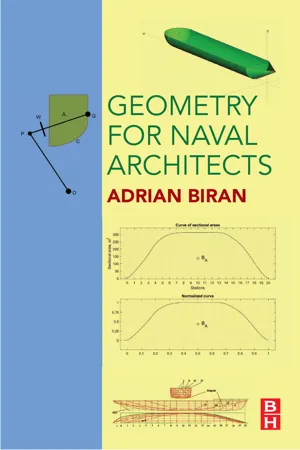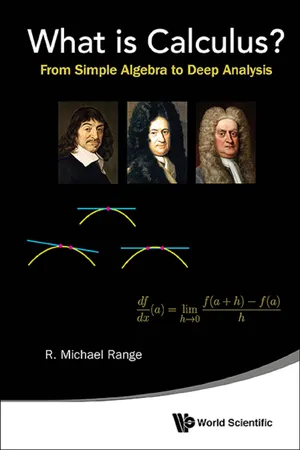Mathematics
Parametric Parabolas
Parametric parabolas are a way of representing parabolic curves using parametric equations. Instead of using the standard form y = ax^2 + bx + c, parametric parabolas use two separate equations to define x and y in terms of a third parameter, often denoted as t. This allows for more flexibility in describing the shape and position of the parabola.
Written by Perlego with AI-assistance
Related key terms
5 Key excerpts on "Parametric Parabolas"
- eBook - ePub
- Adrian Biran(Author)
- 2018(Publication Date)
- Butterworth-Heinemann(Publisher)
Chapter 4Parametric Curves
Abstract
A curve can be represented by an implicit equation,f ( x , y ) = 0,f ( x , y , z ) = 0, by an explicit equation,y = f ( x ),z = f ( x , y ), or by parametric equations,x =,f 1( t )y =,f 2( t )z =f 3( t ) - eBook - ePub
- Fletcher Dunn, Ian Parberry(Authors)
- 2011(Publication Date)
- A K Peters/CRC Press(Publisher)
2 .The curve p (t ) could be infinite, particularly if we place no limits on the range of t . Often it’s useful to select a finite segment by restricting t to a particular bounded domain, most commonly the domain [0, 1]. It’s natural to designate the “forward” direction as the direction of increasing t , so the curve “starts” at t = 0, “ends” at t = 1, and consists of all of the points between.Sometimes we think of the position function p (t ) as a single function that yields a vector result; other times it will be helpful to extract the function for a specific coordinate. For example, the scalar function x (t ) specifies the x -coordinate of p (t ), so in two dimensions p (t ) = (x (t ), y (t )). Notice that each coordinate is specified by a function that depends only on the parameter value so that each coordinate is independent of the others. We work in the plane for the majority of this chapter because almost every important aspect of parametric curves can be demonstrated in 2D and, in general, extension into three dimensions is straightforward.13.1.2 Polynomial Curves
Now that we know what the adjective parametric means, let’s turn our attention to the second important word, polynomial . A polynomial parametric curve is a parametric curve function p (t ) that can be written as a polynomial in t :Polynomial parametric form of arbitrary degree np ( t ) =.c 0+c 1t +c 2t 2+ ... +cn - 1t+n - 1c nt nThe number n is called the degree of the polynomial. Higher degree polynomials are more flexible in the sense that they can describe curves with more “wiggles.” However, sometimes extra “wiggles” come in that we don’t want;1 more on this in Section 13.6 - eBook - ePub
- Morris Kline(Author)
- 2013(Publication Date)
- Dover Publications(Publisher)
t = 1, x = 3, and y = 9. Then (3 , 9) are the coordinates of a point on the curve, namely, the point A , which we discussed earlier. For , x = 4 and y = 16, and (4 , 16) are the coordinates of the point B .We may also say that the two formulas x = 3t and y = 9t 2 are equivalent to the single formula y = x 2 . Whether we speak of equations of curves or formulas is really immaterial. The word formula emphasizes the idea of change because formulas are relationships among variables, and we often like to think of what happens to one variable as another, related variable changes. On the other hand, when a curve is given in its entirety, the concept of change may not be relevant, and then we speak of the equation of the curve.If the two formulas in (1) are entirely equivalent to the single formula y = x 2 , why do we bother with two formulas instead of one? There are two reasons: (1) When one argues from physical principles, it is often easier to arrive at the parametric representation of a given phenomenon, and (2) it is easier to study the phenomenon by working with parametric equations. We shall recognize the utility of parametric representations as we study the next few sections.There is one more mathematical detail. Suppose that we find the parametric formulas describing a motion and we wish to determine the direct relationship between x and y . Can we do this? Yes indeed. For example, if x = 3t and y = 4t 2 are the parametric formulas, we can solve the first one for t and obtain t = x /3. We substitute this value of t in y = 4t 2 - eBook - ePub
- Joy Ko, Kyle Steinfeld(Authors)
- 2018(Publication Date)
- Routledge(Publisher)
In contrast, directly accessing the parametric form requires first deciding on both the properties desired and the best means to describe these properties before anything can be seen. If our only concern is how the curve looks, composing by parameterization would be unnecessary. However, in many design applications, the behavior of the curve is not a negligible factor. Rather than iteratively altering the shape of a curve until it looks right, this functional approach allows us to iteratively alter a description of what the curve does until it acts right. Because of these differences, it is worth becoming comfortable with creating and manipulating geometry in this extraordinarily powerful way. In the following three examples, we will become acquainted with this more direct access to the functional representation of curves. The first example demonstrates the parametric functions of a range of familiar two-dimensional curves, and presents some other more exotic mathematical curves in space as well. The second example focuses on just one class of curve, the helix, and presents an in-depth treatment of how to construct precise control mechanisms in order to achieve specific formal properties. A third example takes a closer look at a technique for producing forms called tweening, and shows how low-level control can overcome the undesired results that easily occur when working with curves in CAD. EXAMPLE El.18 A Gallery of Parametric Curves Previous examples have demonstrated the wealth of mathematical curves available to us, and the often confounding relationship between parametric equations and the forms of curves they produce - eBook - ePub
What is Calculus?
From Simple Algebra to Deep Analysis
- R Michael Range(Author)
- 2015(Publication Date)
- WSPC(Publisher)
In particular, parabolas arise when the plane is parallel to the mantle of the cone. The great geometer Apollonius (3 rd century B.C.) is credited with systematically recording the geometric definitions and known properties of the conic sections, and with discovering many additional properties. In particular, Apollonius discovered—in geometric language—a description of the parabola that is equivalent to the familiar algebraic formulation in Cartesian coordinates that we shall recall below. Most important for our discussion, based on this characterization, Apollonius deduced the following geometric construction of the tangent to a parabola at a point P. As shown in Figure 7, the (perpendicular) projection of P onto the axis of the parabola identifies a point at distance d from the vertex V. Consider the point Q on the extended axis that is at the same distance d from V on the opposite side. The tangent to the parabola at P is then that line through P that goes through the point Q. Let us now translate geometry into algebra and apply the double point method—which was so successful for a circle—to determine the tangents to a parabola. We place the vertex V at the center (0, 0) of a Cartesian coordinate system and choose the axis of the parabola along the positive y -axis. The equation of the parabola is then y = λ x 2 for some λ > 0 that depends on the distance between the vertex and the focus. Let us fix a point (a, b) on the parabola. As before, any (non-vertical) line through (a, b) has an equation y = b + m (x − a). Its points of intersection with the parabola are the solutions of After replacing b = λ a 2 (the point (a, b) is on the parabola), this equation factors into The two solutions are a and m / λ − a. Consequently (a, b) is a double point of intersection of the line with slope m precisely when a = m / λ − a, or m = 2 λa. Example. At the point (−1, 1) the slope of the tangent to the graph of f (x) = x 2 equals 2(−1) = −2
Index pages curate the most relevant extracts from our library of academic textbooks. They’ve been created using an in-house natural language model (NLM), each adding context and meaning to key research topics.




